Acids, Bases, and pH
Summary
TLDRIn this educational video, Mr. Andersen delves into the concept of acids, bases, and pH, crucial for understanding biological processes. He explains that pH measures the concentration of hydrogen ions, with 7 being neutral, below 7 acidic, and above 7 basic. Using water as a starting point, he illustrates how hydrogen bonding leads to the formation of hydronium ions, affecting pH. The video further discusses the impact of pH on proteins, such as myoglobin in muscles, and the environmental implications, including acid rain and ocean acidification, emphasizing the importance of pH stability for life and ecosystems.
Takeaways
- 😀 pH measures the concentration of hydrogen or hydronium ions in a solution, indicating whether it's an acid or base.
- 😀 Water has a neutral pH of 7, with acids having a lower pH and bases a higher pH than 7.
- 😀 Proteins like myoglobin in muscles function best within a specific pH range (5-7), and deviations can cause denaturation.
- 😀 Water molecules are polar, forming hydrogen bonds between molecules, which is crucial for water's properties like cohesion.
- 😀 Hydronium ions (H3O+) form when a hydrogen atom detaches and attaches to another water molecule, influencing pH levels.
- 😀 pH is calculated as the negative logarithm of the hydrogen ion concentration, making it a log scale for acidity and basicity.
- 😀 Hydrochloric acid (HCl) dissociates in water, increasing H+ concentration, lowering pH, making the solution more acidic.
- 😀 Sodium hydroxide (NaOH) acts as a base, reducing hydrogen ion concentration by forming water, raising the pH.
- 😀 The oceans' pH has been decreasing due to carbon dioxide combining with water, leading to ocean acidification.
- 😀 Even a small change in pH can have significant biological impacts, including coral reef damage and mass extinctions tied to acidification.
Q & A
What does pH measure?
-pH measures the concentration of hydrogen ions or hydronium ions in a solution.
Why is pH important in biology?
-pH is important in biology because it affects the activity of proteins like myoglobin, which is found in muscles and is most active at a pH of 6. Extreme pH levels can cause proteins to denature, affecting the functioning of muscles and other biological processes.
What is the significance of the pH of water being 7?
-A pH of 7 for water indicates neutrality, meaning the concentration of hydrogen ions is balanced and rare, occurring at a rate of about 1 in 10,000,000.
What is a polar molecule and how does it relate to water?
-A polar molecule is one where electrons are unevenly distributed, resulting in partial positive and negative charges. Water is a polar molecule because oxygen pulls electrons towards itself, creating a partial negative charge, while hydrogen has a partial positive charge.
What is a hydrogen bond and how does it occur in water?
-A hydrogen bond is a type of dipole-dipole attraction between a partially positive hydrogen atom in one water molecule and a partially negative oxygen atom in another. This results in water molecules aligning in a way that allows them to be attracted to each other, contributing to properties like cohesion.
What is hydronium and how is it formed?
-Hydronium is formed when a hydrogen atom from one water molecule becomes detached and attaches to another water molecule, resulting in H3O+ with a positive charge. This leaves behind a hydroxide ion (OH-).
How is the pH scale related to acids and bases?
-The pH scale is used to measure how acidic or basic a substance is. A pH of 7 is neutral, values below 7 indicate acidity (with lower numbers being more acidic), and values above 7 indicate basicity (with higher numbers being more basic).
What happens to the pH when hydrochloric acid is added to water?
-When hydrochloric acid is added to water, it dissociates into hydrogen ions and chloride ions, increasing the concentration of H+ ions and thus lowering the pH, making the solution more acidic.
How does sodium hydroxide affect the pH of water?
-Sodium hydroxide, when added to water, dissociates into sodium ions and hydroxide ions. The hydroxide ions react with hydrogen ions in the water to form more water molecules, reducing the concentration of H+ ions and thus raising the pH, making the solution more basic.
What is the relationship between pH and the environment?
-Changes in pH can have significant environmental impacts. For example, acid rain and the acidification of oceans due to increased carbon dioxide levels can alter the pH, affecting marine life and ecosystems.
Why is it important to understand the pH scale in the context of environmental issues?
-Understanding the pH scale is crucial for assessing environmental issues like ocean acidification because even small changes in pH can have large effects on the concentration of hydrogen ions, which in turn can impact marine life and ecosystems.
Outlines

This section is available to paid users only. Please upgrade to access this part.
Upgrade NowMindmap

This section is available to paid users only. Please upgrade to access this part.
Upgrade NowKeywords

This section is available to paid users only. Please upgrade to access this part.
Upgrade NowHighlights

This section is available to paid users only. Please upgrade to access this part.
Upgrade NowTranscripts

This section is available to paid users only. Please upgrade to access this part.
Upgrade NowBrowse More Related Video

The Four States of Matter - Explained

Lab Equipment - Explained

3. Gr 11 Life Sciences - Population Ecology - Theory 3 Mark Recapture Method

4. Gr 11 Life Sciences - Population Ecology - Worksheet 1

PENJASKES KELAS X - SOFTBALL

Introduction to Culture [AP Human Geography Review Unit 3 Topic 1]

Menentukan Mr ( massa molekul relatif )
5.0 / 5 (0 votes)